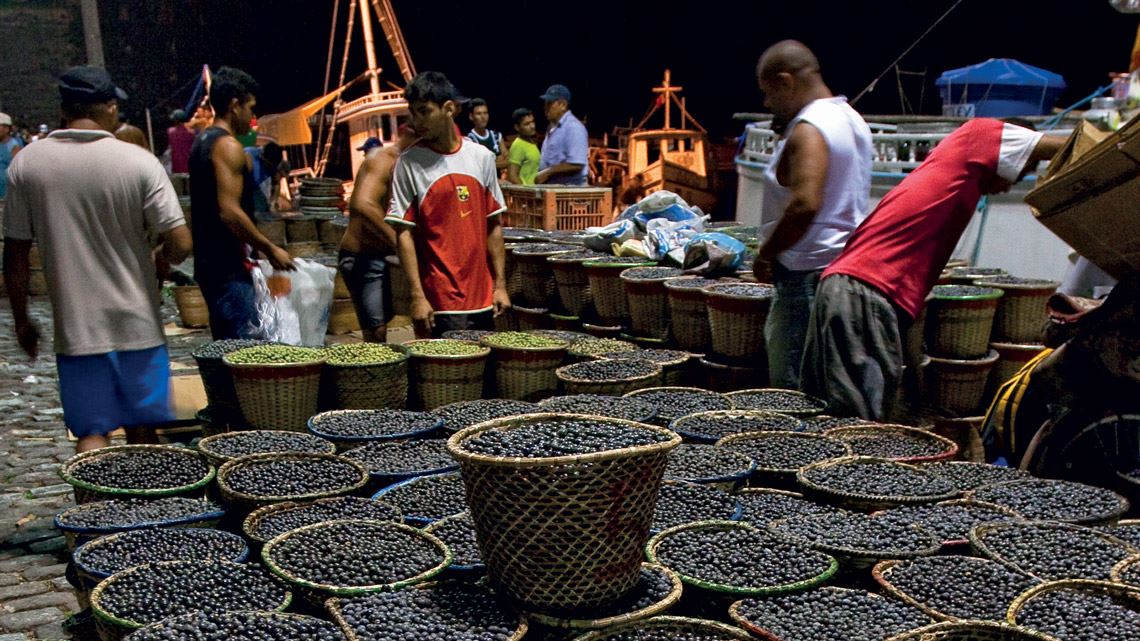The most promising source of wealth and value creation in Brazil over the coming decades may well be beneath our feet and right before our eyes. The rich biodiversity contained in the country’s six biomes (or seven, if including the ocean), its abundant farmland, water, and sunshine, and the advanced farming techniques its researchers have mastered for a wide range of crops, provide ideal conditions for a set of regenerative, circular, and sustainable economic activities known collectively as the bioeconomy—a sector that has risen to prominence globally over the previous decade.
The current transition to a sustainable economy offers a unique window of opportunity for Brazil, the most biodiverse country in the world. Apart from the Amazon rainforest, famous for its profusion of plant and animal species, Brazil is home to the most biodiverse tropical savanna in the world, known as Cerrado, and the world’s most biodiverse savanna steppe, called Caatinga, notes Carlos Nobre, a senior climate researcher at the Brazilian National Institute for Space Research (INPE) and cochair of the Scientific Panel for the Amazon, a United Nations (UN) initiative to collect data about the region. The sea along Brazil’s 8,500 kilometers of coastline also offers vast potential to be explored. But this will require an effort to adapt the economy, in a transition that needs to happen quickly: with the current climate crisis and the advancing deforestation frontier, there is a real risk that these resources could be lost.
The term bioeconomy is variously defined. In 2009, the Organization for Economic Cooperation and Development (OECD) published a report, “The Bioeconomy to 2030: Designing a Policy Agenda,” in which it defines the bioeconomy as “a world where biotechnology contributes to a significant share of economic output.” In 2019, the Brazilian Ministry of Science, Technology, Innovation, and Communications (MCTIC, now renamed the MCTI) published an Action Plan on Science, Technology, and Innovation for the Bioeconomy (PACTI Bioeconomia), in which the bioeconomy is described as “a set of economic activities based on the sustainable and innovative use of renewable biological resources (biomass) in replacement of fossil raw materials for the production of food, feed, materials, chemicals, fuels, and energy, using biological, chemical, thermochemical, or physical processes.”
For economist Edson Talamini, coordinator of the Center for Bioeconomic Research Applied to Agribusiness (NEB-Agro) at the Federal University of Rio Grande do Sul (UFRGS), the bioeconomy involves a broader approach to sustainability in manufacturing than one that focuses on carbon emissions only. It is also takes economic sustainability and, especially, thermodynamic efficiency into account. “Some processes may seem sustainable from a price or job perspective, but when we look closer, we find they carry a higher cost to achieve the desired effect, with irreversible consequences,” he says. “The bioeconomy is about processes at the molecular level and how production activities compare to each other on sustainability.”

Westend61 / Getty Images
An aerial view of the Amazon forest in Itaituba, ParáWestend61 / Getty ImagesReindustrialization
Brazilian researchers in the field see the bioeconomy not only as an opportunity for economic growth, but also as a springboard for a new cycle of industrialization. The Amazon forest will likely be a major powerhouse in this new economy as a biome that can sustain a thriving industry based on innovation and sustainability, according to a report, “Amazônia e bioeconomia” (The Amazon and the bioeconomy), recently published by the Institute of Engineering in collaboration with scientists at EMBRAPA, INPE, the University of São Paulo (USP), the University of Campinas (UNICAMP), and other institutes.
But the Amazon has also been a center of negative attention over its deforestation belt and environmental degradation caused by new hydroelectric dams and unregulated gold mining, including on Indian reservations. Known for his theory that continued deforestation will lead to a tipping point at which the Amazon region might turn into parched scrubland, with an extended dry season, Nobre believes the race against time to save the biome will be a tight one. Data collected by the INPE suggest that in deforested areas of the Amazon in northern Mato Grosso and southern Pará, carbon sequestration capacity has been lost and the forest has become a net producer of carbon dioxide, the most important greenhouse gas.
Nobre is spearheading a project, called Amazon 4.0, that would place the vast South American biome at the center of a potential bioindustrial revolution. This standing-forest bioeconomy would generate products with varying levels of complexity and technological content. By combining biotechnological research with the production of non-timber forest products, forest stewardship, and regenerative agriculture, the initiative could create a “third way” for Amazon development. This model differs from both the approach of setting aside large tracts of Amazon forest for conservation purposes, leaving the remainder for economic activities that are not necessarily sustainable (the first way); and the approach of concentrating livestock, mining, and hydropower operations in areas that have already been degraded (the second way).
José Vitor Bomtempo, coordinator of the Bioeconomics Research Group at the School of Chemistry, Federal University of Rio de Janeiro (GEBio-EQ/UFRJ), says Brazil has a unique opportunity to reindustrialize on a sustainable basis. Unlike modernization efforts in the previous century, it is now no longer about catching up with other countries’ industries and technology. This time the opportunity and challenge will be to put the country at the technological frontier from day one.
A report published by the Brazilian Development Bank (BNDES) in 2018, titled “A bioeconomia brasileira em números” (Brazil’s bioeconomy by the numbers), placed the annual value of the sector at US$285.9 billion, including exports. The report was authored by Bomtempo in collaboration with engineers Martim Francisco de Oliveira e Silva and Felipe dos Santos Pereira, of BNDES. At the time of writing the report, that figure was equivalent to 13.8% of Brazil’s GDP, only slightly less than the 14.3% estimated for the European Union’s bioeconomy in 2013.
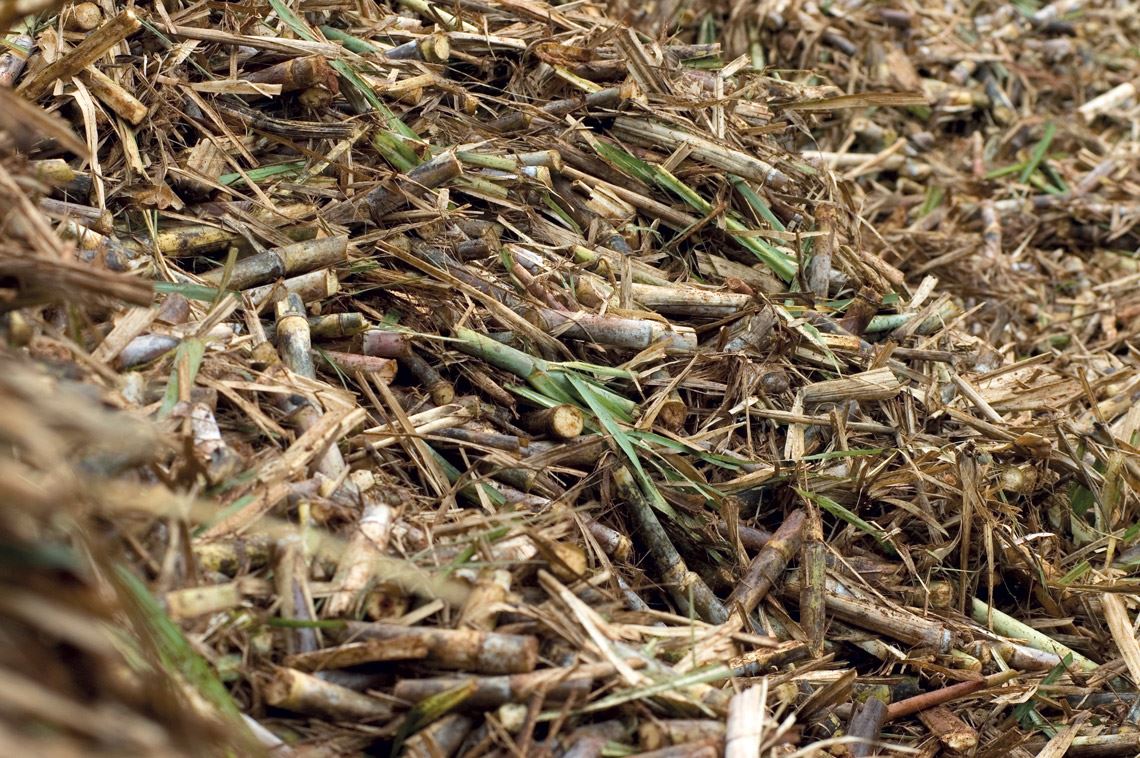
Eduardo Cesar
Sugarcane cut into billets before being fed into the ethanol production processEduardo CesarBut this should not be interpreted to mean Brazil is doing well in leveraging its potential. “This figure accounts for Brazil’s production and exports of agricultural commodities, which have limited added value. “The so-called advanced bioeconomy is still incipient here,” says Bomtempo. The study estimates that bioeconomy content in Brazilian manufacturing and services amounts to a paltry US$101.4 billion, or 2.6% of these sectors’ total worth. “The data reveal a bioeconomy at its infancy,” he says.
The leading players in Brazil’s current bioeconomy are large corporates using biodiversity to produce consumer goods, fuels, and biodegradable materials. One example is cosmetics maker Natura (see article on page 83). The energy sector boasts some of the biggest success stories. Raízen in Piracicaba, southeastern Brazil, and Granbio in São Miguel dos Campos, northeastern Brazil, are a case in point—both have developed capabilities to produce second-generation ethanol from sugarcane bagasse and other agricultural waste.
Bomtempo notes that one obstacle to the development of the bioeconomy has been that related initiatives are thinly dispersed. Oil refineries and petrochemical plants, in contrast, are clustered into hubs, a model that needs to be replicated with biorefineries. Just as the oil industry processes raw materials into a wide variety of products—ranging from fuels to active ingredients for drugs—biorefineries could also process all parts of their agricultural raw materials (peels, pulp, sugarcane trash and bagasse, seeds) into a range of food products, biofuels, and other biomaterials.
Bomtempo believes that second-generation biorefineries could form clusters where multiple companies form an integrated value chain, with the waste from one company serving as a raw material for the other, in what he terms as “industrial symbiosis.” ARD (Agricultural Research for Development), an industrial park near Reims, France, is an example of a project using this model. “The site houses multiple, interdependent facilities. The waste from one plant is a feedstock for another. They use wheat, beets, alfalfa, and a wide range of other raw materials to produce different types of goods. The facilities are highly integrated and mutually complementary, and include a research center,” he says.
José Maria Ferreira Jardim da Silveira, an economist with a degree in agricultural engineering at the UNICAMP Institute of Economics, refers to this as “economy of scope,” or efficiency generated by variety rather than the volume of products, which he sees as vital for a viable bioeconomy. Just as some sugar and ethanol mills generate electricity by burning sugarcane trash and bagasse, Silveira suggests that large biogas plants could be built to handle municipal waste. Other adjacent operations could then be created around them. “Stillage, a byproduct from the production of second-generation ethanol, could be used to produce biogas. Sugarcane cellulose also contains compounds that can be processed into biofuels. With each added operation, a biorefinery would become more efficient,” he says.
For now, these models are still at a very incipient stage of development, with only a handful of prototypes being tested at university laboratories and startups. At the Federal University of Rio Grande do Sul (UFRGS), a laboratory run by the Process Intensification, Modeling, Simulation, Control, and Automation Group (GIMSCOP), under chemical engineer Jorge Otávio Trierweiler, is developing a concept of decentralized biorefineries that are highly automated and operated remotely from a control center. Three different research projects are being developed within this concept: one to produce ethanol, sugar, and spirits from sweet potatoes; a rapid pyrolysis process to produce oil from biomass; and a process to generate microalgae for use in bioremediation of water and soil, as well as bio-oil and other products. The two first processes are currently at a TRL (Technological Readiness Level) of 3 and 4, on a scale of 1 to 9, says Trierweiler.
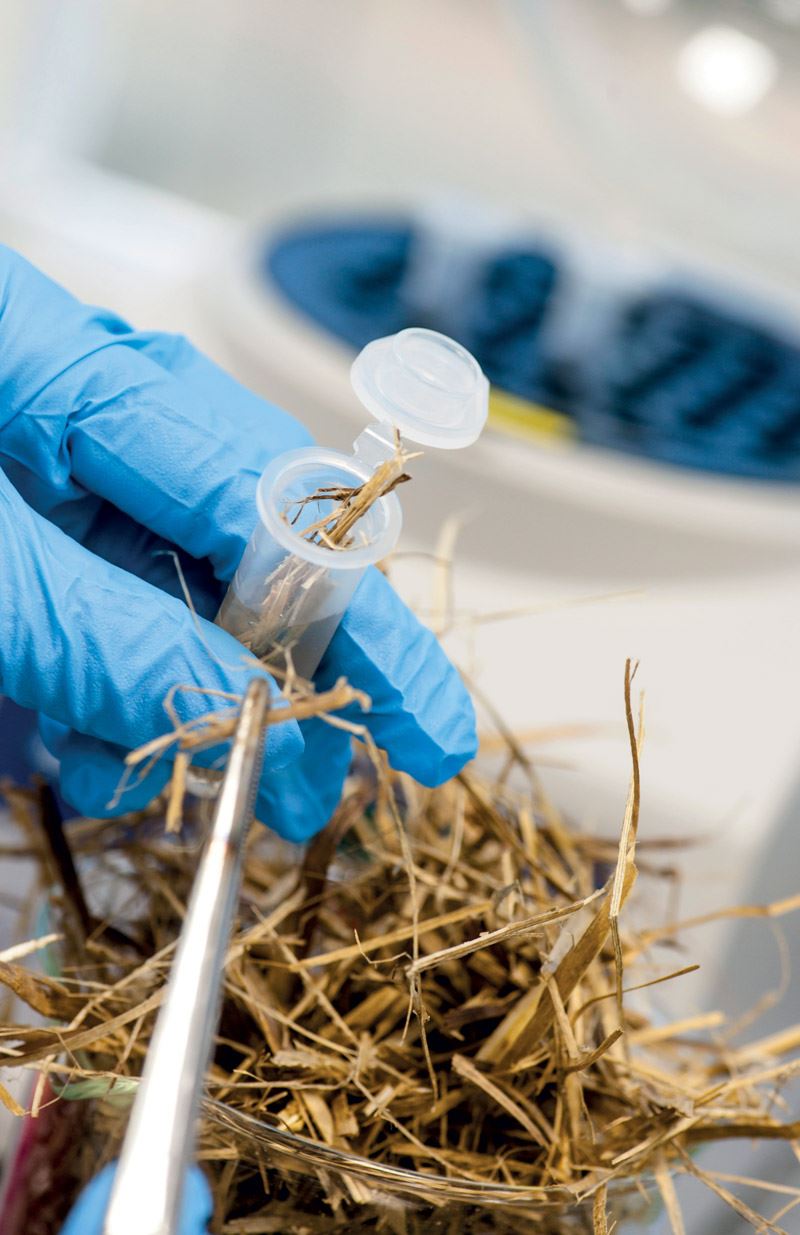
Léo Ramos Chaves
Sugarcane trash being analyzed at a molecular biology laboratory at GranbioLéo Ramos ChavesAdvanced research
The bioeconomy is knowledge-intensive and will require more than just biodiversity and available resources. It will rely on both advanced science to develop new products and perfect existing ones, as well as traditional knowledge held by collector communities who have lived in forests or other biomes for generations.
On the advanced research front, FAPESP has three programs that are related to the bioeconomy although they predate the use of the term in Brazil, notes physicist Carlos Henrique de Brito Cruz, senior vice president of Elsevier Research Networks, who formerly served as scientific director at FAPESP from 2005 to 2020. The Research Program on Biodiversity Characterization, Conservation, Restoration, and Sustainable Use (BIOTA), launched in 1999, works to catalog and characterize Brazilian biodiversity. The Bioenergy Research Program (BIOEN), created in 2009, conducts research on biofuels such as bioethanol, biodiesel, and biogas, while the FAPESP Research Program on Global Climate Change (PFPMCG), launched the same year, is tasked with developing measures and technologies to mitigate impacts from climate change.
“Well before the term bioeconomy became a buzzword, scientists were already exploring these issues at FAPESP and drawing attention to the importance of bioenergy, biodiversity, and climate change,” says Brito Cruz, a co-author of “The Amazon and the bioeconomy” report. “These are examples of how science can point the way for a country, and how scientists can look beyond at what’s ahead and apply that foresight to current problems.”
“The BIOEN program was initially focused on exploring possibilities in the sugar and ethanol industry but has now expanded its scope to other sources of biomass, of which there is a wealth in Brazil,” says Glaucia Souza, a professor of biochemistry at the USP Institute of Chemistry and one of the program’s coordinators. “We knew this would create significant opportunities in Brazil and globally, such as new lignin-based biomaterials that can even replace cement.”
Physicist Paulo Artaxo, a professor at the USP Institute of Physics, and a coordinator of the Climate Change Program, says one of the reasons the program was created was the realization that “no industry will escape the impacts of climate change. We will need to rethink our social and economic system, as the current one is unsustainable even in the short term, in a world with finite resources.”
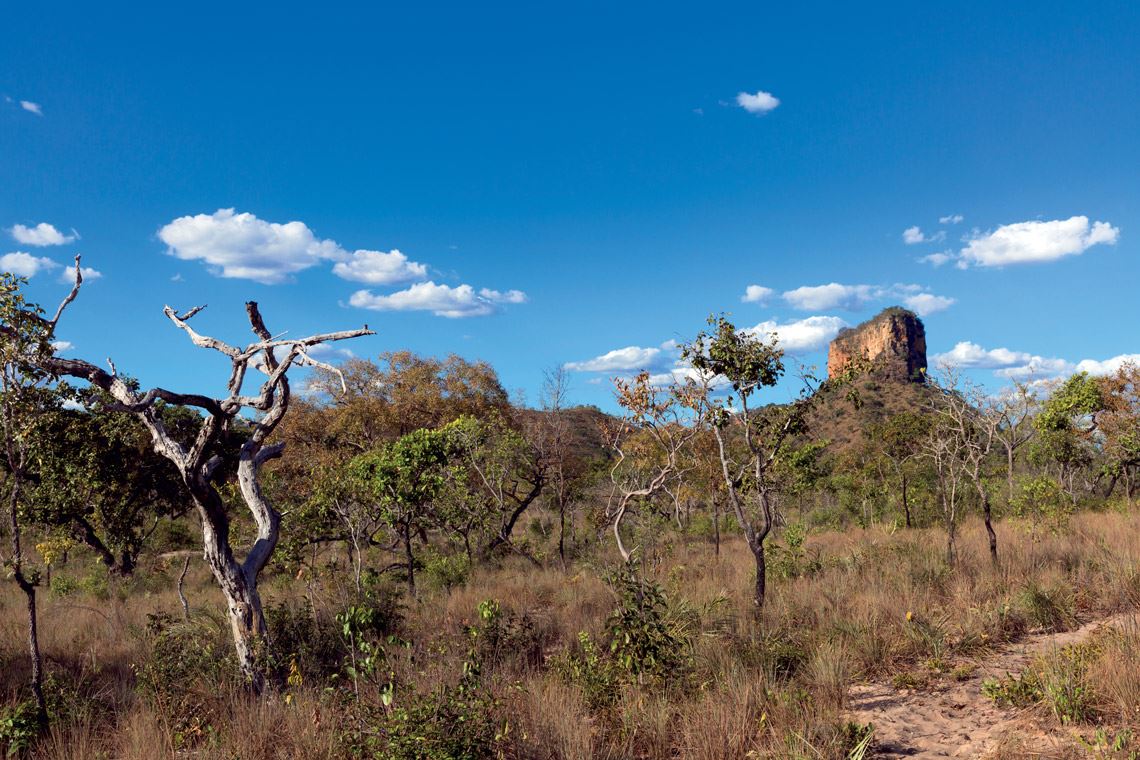
Pedro Moraes / Getty Images
Brazil’s Cerrado, the most biodiverse tropical savanna in the worldPedro Moraes / Getty Images“The question is: how will we transition to a more sustainable economic system that uses the world’s natural resources more intelligently and efficiently and reduces social inequalities? These are key questions that science needs to answer. If the answer is not solidly grounded in science, our society will always be at the mercy of economic interests,” he says.
For Brito Cruz, technology and research developed at Brazilian universities and laboratories provide an opportunity to rethink the relationship between the private sector and government. He believes governments should invest where industry cannot because either the risks are too high or the returns to low. Government investment should supplement and induce, but not replace, private investment in R&D.
Paulo Camuri, a senior economist at the World Resources Institute Brazil (WRI Brazil), believes leadership from the public sector remains essential despite the current fiscal constraints. “The government provides policy guidance and lays out action plans. Funding institutions like the BNDES can fund part of the investment if necessary. The private sector can then provide the bulk of the funding. Companies are looking to invest in projects that can support the transition to a sustainable economy, but don’t always know where to invest. The government can help to reduce uncertainty,” he argues.
In a report released last year, titled “A New Economy for a New Era,” researchers at WRI Brazil explored the potential benefits from decarbonization for Brazil’s economy. The bioeconomy is a core component of WRI Brazil’s proposed pathway forward. “If well managed, natural capital can be a major asset in a new growth model for Brazil that boosts social inclusion. It’s not a trade-off between growth, social inclusion, and environmental sustainability. Decarbonization can lead to both increased growth and greater social inclusion than if we maintain the status quo,” says Camuri.
In agriculture, one example of how the public sector can guide the way for the private sector is the Sectoral Action Plan for Climate Change Mitigation and Adaptation and a Low Carbon Economy in Agriculture (ABC Plan). Launched in 2010 by the Ministry of Agriculture, the plan was reformulated in April last year and renamed as ABC+. “The plan aims to facilitate access to a range of enabling technologies to reduce emissions, such as landscape-integrated agriculture,” says Camuri. The biggest barriers to implementation, explains the economist, have been a lack of technical assistance and funding. The federal government’s annual funding bill for agriculture (Plano Safra) earmarked R$236 billion in funding for 2020, one third of the amount needed to fund agricultural production in the year. The ABC Plan accounted for slightly more than 1% of this amount: R$2.5 billion in 2020. Camuri believes that a transition to a bioeconomy would require that the share of funding for the ABC+ Plan be increased “to a point where it accounts for virtually all funding under the Plano Safra. This would send a clear signal to the private sector.”
A prime example of a non-timber forest product that is helping to keep forests standing in Brazil is açaí. In Brazil’s Amazon states, the market for this superfruit is worth R$3 billion annually, with a local economic impact of R$144 million for açaí pickers and R$146 million for growers, according to the most recent social report published by the Brazilian Agricultural Research Corporation (EMBRAPA), in 2019. Originally consumed as an accompaniment with cassava meal and fish, açaí has been incorporated into new recipes in other regions of Brazil, and has become an export product during the last decade. Açaí and other products such as babaçu, Brazil nuts, and tonka beans have made Brazil’s North an important hub for non-timber forest products (NTFPs), accounting for 45% of the country’s production and more than R$700 million in revenues per year. Ranking second is the South, representing 29% of Brazil’s output of NTFPs, and R$445 million in annual revenues.
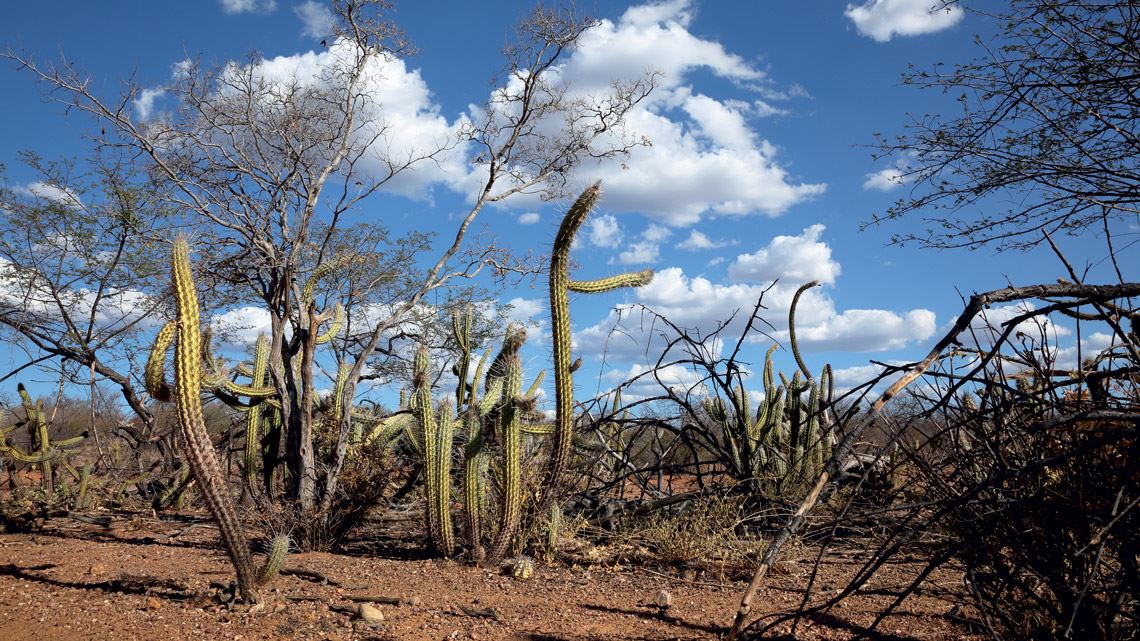
Heckepics / Getty Images
The species-rich Caatinga, the world’s most biodiverse savanna steppeHeckepics / Getty ImagesTotal revenues from NTFPs are worth R$1.6 billion annually, according to data from the Brazilian Institute of Geography and Statistics (IBGE). Sandra Regina Afonso, an agricultural engineer at the Brazilian Forestry Service and a professor at the University of Brasília (UnB), notes that the revenue data are a rough estimate and almost certainly understated. For example, revenue data for pequi, a fruit harvested in northern Minas Gerais, the Midwest, and the Northeast, only included revenue from oil production up to 2014, but not sales of the fruit proper. Revenue from babaçu coconuts, found in the Northeast and North of Brazil, is calculated only for the nuts and not for all products produced from the entire coconut.
In her book, Bioeconomia da floresta: A conjuntura da produção florestal não madeireira no brasil (The forest bioeconomy: Production of non-timber forest products in Brazil), published by the Brazilian Forestry Service, Afonso discusses some of the main NTFPs on the market and related government policies and programs, such as the National Plan for the Promotion of Socio-Biodiversity Product Chains, launched in 2009, and the Brazil Socio-Biodiversity Bioeconomy Program, introduced in 2019. “Non-timber forest products are linked to forest stewardship and their use is connected to people’s culture,” she notes. “This is expressed by the word socio-biodiversity. The term bioeconomy adds the notion of technology and innovation, through which forest products gain added value and quality so they can be marketed at greater scale.”
Challenges
Researchers recognize that achieving development and reindustrialization in Brazil via the bioeconomy will not be a simple task. It will require a concerted effort by government, the private sector, and scientific institutions. “The bioeconomy is a guidepost, a framework of action that informs public policy and incentives for private actors,” summarizes Silveira of UNICAMP, noting the importance of ensuring regulations are in step with advancing technology. Regulation provides the frameworks needed for markets to develop. Silveira cites biogas as an example, which in its most rudimentary form—the product of decomposing plant and animal remains—is only usable as fuel at large plants. “But evolving technology has led to the development of biomethane, which can be delivered to households via natural gas distribution systems. This has required regulations and standardization to develop the market at scale,” he says.
Souza, of USP, says one of the major barriers to development of the bioeconomy is the lack of “a clear, transparent, stable, predictable framework, and public policies at a global scale” to harmonize standards and legislation and provide a secure environment for investment. “If a major shipping company decided to retrofit its ships to biofuel, for example, what assurance would it have that there would be a large enough market to supply biogas at the required scale?” Souza also believes further progress is needed in certification and product traceability, to avoid sustainability claims being made by polluting products.
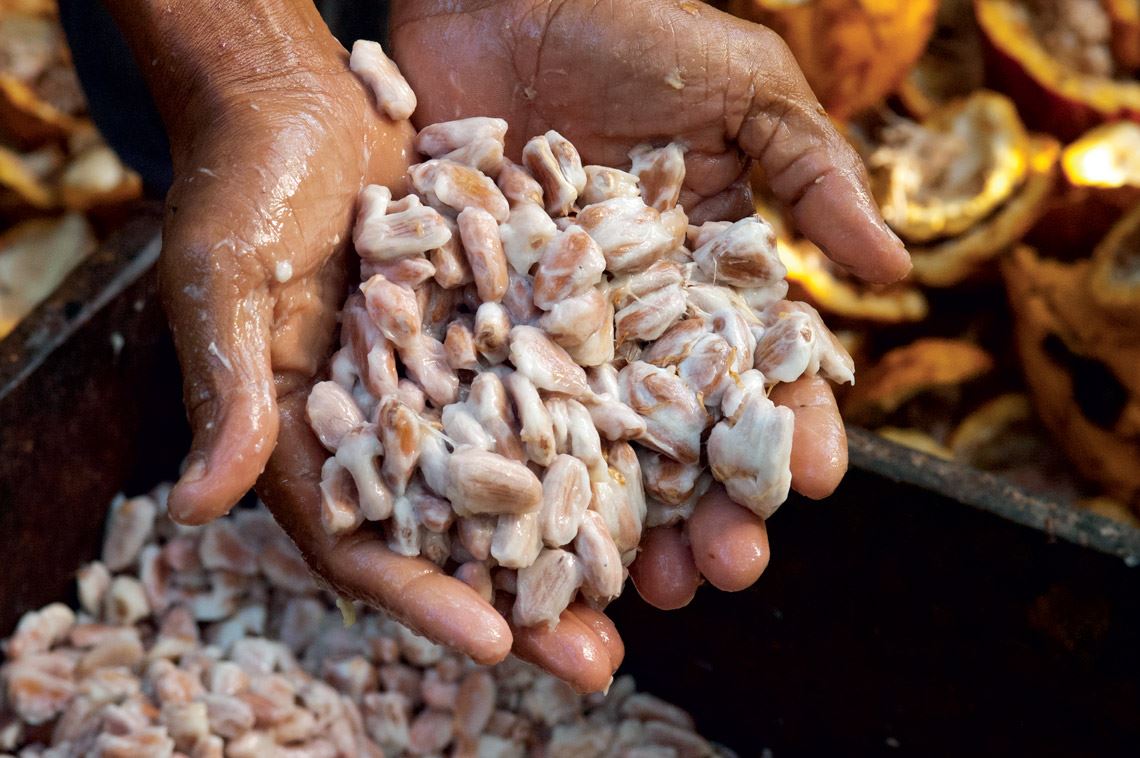
Eduardo Cesar
Developing an Amazon bioeconomy will require “creative laboratories” to produce, for instance, cocoa-based productsEduardo CesarRegulation has been a major roadblock to the development of the sector in Brazil in the past decades, says Carlos Alfredo Joly, a biology professor at the UNICAMP Institute of Biology and a coordinator of the FAPESP BIOTA program. “Since its inception, the BIOTA program has included an important bioprospecting component [the search for and identification of commercially valuable molecules and metabolic processes in plants, animals, and microorganisms] that has identified several molecules with immediate commercial applications. But the regulatory framework (Executive Orders 2052/2000 and 2186-16/2001] created legal uncertainty and this made the private sector hesitant. We were in talks with companies in the pharmaceutical and cosmetics industries, but these regulations dealt us a virtually fatal blow,” she says. “This later changed with the Biodiversity Law [no. 13123/2015] and its regulatory decree [no. 8772/2016].” Although there has been some improvement, significant challenges remain, says Souza, citing the slow-moving implementation of the National System for the Management of Genetic Heritage and Associated Traditional Knowledge (SisGen).
Nobre believes that developing an Amazon bioeconomy will require “creative laboratories” operating within the region alongside the currently underutilized ecosystem of universities and research centers. The Amazon 4.0 project is operating at experimental facilities in São José dos Campos, southeastern Brazil, and is seeking funding to set up facilities within the Amazon. These laboratories are already producing products from cocoa and cupuaçu (chocolate and “cupulate”), as well as gourmet oils from nuts, tucumã, bacuri, and patauá.
Although recognizing the value of the PACTI Bioeconomia program, Talamini of UFRGS says public policy support has been modest at best. “It’s a shame that Brazil is only know awakening to the vast potential of the bioeconomy. There are several promising initiatives at EMBRAPA, at universities and in some companies, but they lack central coordination,” he says. “As a country with a strong agricultural sector, there are plenty of initiatives to generate energy from waste, but it doesn’t go much further than that. Scientific output is underutilized,” says Talamini, noting that in Europe, in contrast, research is focused on developing new ways to create value from biomass. In the US, the emphasis is on biotechnology. “Brazil has the potential to engage on both fronts, with its abundant supply of water, sunlight, and land to produce biomass. It has remarkable biodiversity. And it has researchers who can develop technologies to convert that biodiversity into value,” he says.
Bomtempo points to recent initiatives within the Bioeconomy Opportunities and Challenges (ODBio) program, an offshoot from the PACTI plan led by the Center for Management and Strategic Studies (CGEE). ODBio is an effort to accelerate progress in the bioeconomy sector, explains Bomtempo.
For Talamini, the pandemic has opened the world’s eyes to the need for a green economic recovery, and this creates an enormous opportunity for Brazil. How much potential the country will capture in the bioeconomy will depend on policy decisions. “In the past, we resigned ourselves to exporting commodities. My fear is that this could be repeated with the bioeconomy. We will be exporting diversity and importing high value-added materials if our focus is only on upstream inputs. We cannot neglect the processes midstream. This will require integration, incentives, and research,” he says.
A Brazilian pioneer of nature-based cosmetics has invested heavily in bioingredients
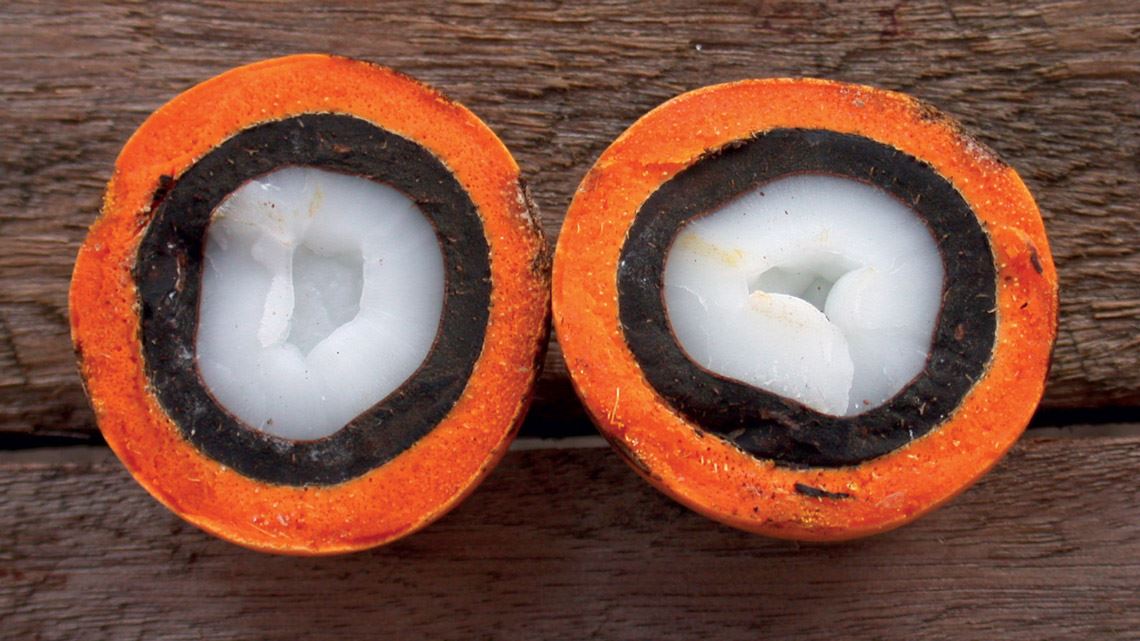
P. S. Sena / Wikimedia Commons
Tucumã: edible fruits with seeds that can be used as ingredients for moisturizers and anti-aging productsP. S. Sena / Wikimedia CommonsPerhaps the best-known success story of transforming raw materials from socio-biodiversity into world-class products is Natura, a Brazilian cosmetics company founded in 1969. “This provides a good case study, as cosmetics are a sector in which Brazil has strong potential for advancement in the market for bio-based products,” says José Vitor Bomtempo, an economist and chemical engineer who is coordinating the Bioeconomics Research Group at the School of Chemistry, Federal University of Rio de Janeiro (GEBio-EQ/UFRJ). According to research firm Euromonitor, Brazil’s personal care, fragrances, and cosmetics sector was worth R$122.4 billion in 2020, growing 4.7% from 2019, while GDP shrank by 4.1%.
Natura’s flagship biodiversity brand, Ekos, was launched in 2000 with a range of skin and hair care products containing natural ingredients substituted for synthetic ones, in a process the company terms as “vegetalization.” According to market research from Grand View Research, the natural cosmetics market is projected to grow to US$48 billion by 2025.
The launch of Natura’s Ekos product range came with a growing focus on the Amazon region that culminated in 2011 in the creation of its Amazonia Program. Through this program, the company has helped to preserve 2 million hectares of forests, including the harvesting areas of its partner collector communities and three protected areas: the Uacari (Amazonas) and Iratapuru River (Amapá) sustainable development reserves, and the Middle Juruá (Amazonas) NTFP Reserve.
The program has implemented many of the elements that researchers have ascribed as vital to the bioeconomy, including investment in cutting-edge research and partnerships with local producers and collector cooperatives. Natura’s Ecopark, an industrial complex located at a 172-hectare site in the city of Benevides, northern Brazil, is an icon of the company’s investment in research. Apart from producing soap bars, the center is developing new value chains for plant species with untapped commercial potential. Other companies have also set up research facilities at the site, such as German-based Symrise.
The complex is a branch of the Natura Amazônia Innovation Center (NINA), which has collaborations with institutions such as the Federal University of Amazonas (UFAM), the Brazilian Agricultural Research Corporation (EMBRAPA), the Amazonas State Research Foundation (FAPEAM), and the Brazilian Agricultural Research Corporation (EMBRAPA).
In 2020 Natura posted R$2.14 billion in revenues from businesses linked to socio-biodiversity. The company’s products use 38 different bioingredients, with 17.8% of its raw materials sourced from the Amazon in partnership with 7,039 collector families. Natura signed its first ingredient sourcing agreement with the Iratapuru River Collector Cooperative (COMARU), in the northern municipality of Laranjal do Jari, Amapá. The cooperative collects Brazil nuts and breu branco resin as ingredients for the company’s Ekos range. Natura now has partnerships with 40 communities and 8,300 families in socio-biodiversity value chains throughout Brazil.
Last year the company launched an initiative, dubbed Nós da Floresta (“We of the Forest”), to strengthen the innovation and entrepreneurship ecosystem in the region in partnership with Rede Jirau Agroecologia and non-government organizations Alegria and Conexões Sustentáveis (CONEXSUS). The initiative has identified three challenges that need to be overcome in order to unlock the bioeconomy: fostering local business, addressing bottlenecks in value chains, and boosting revenues for community organizations.


